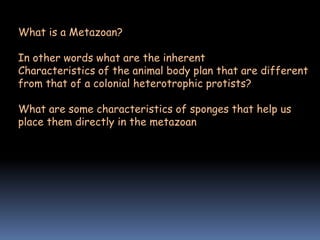
Cnidaria1.ppt
- 1. What is a Metazoan? In other words what are the inherent Characteristics of the animal body plan that are different from that of a colonial heterotrophic protists? What are some characteristics of sponges that help us place them directly in the metazoan
- 2. Phylum Placozoa -- 2-3 mm, 25 um- thick, resembling a large ameba -- Lacks anterior posterior polarity -- Asexual reproduction is prevalent --The most primitive animal? Trichoplax adhaerens
- 3. Phylum Placozoa Dorsal Fiber synctium cilium epithelium-like layer thick glandular layer Flagellated cells -- Feed ventrally by absorption of digested material -- Lack organs but tissue-like outer walls -- A bit more than 2000 cells -- Only 4 different cell types - (20 in sponges; > 220 in mammals) -- Smallest genome of all animals Intercellular junctions
- 4. Three competing Scenarios A. Earliest view of them as the basal metazoan B. Special cellular junctions consisting of two opposing dense plaques (desmosomes) not found in most sponges C. 16S rRNA data…maybe secondarily simplified from more complex ancestors? Epitheliozoa Eumetazoa Functional Morph.
- 5. Mitochondrial genome of Trichoplax adhaerens supports Placozoa as the basal lower metazoan phylum Dellaporta, Stephen L. et al. (2006) Proc. Natl. Acad. Sci. USA 103, 8751-8756 Largest known mt genome 46 kbp, 2x that of most metazoa with introns and other intrageneic spacers and large protein coding regions that are usually lacking in other animals Blue: known mt proteins Gray: ribosomal genes Green: unknown open reading frames Red lines: introns
- 7. More than 9, 000 species, including jellyfish, corals, anemones, hydroids and much much more. Phylum Cnidaria
- 8. Themes General characteristics of Cnidaria Why are they successful? Cnidaria Diversity and Taxonomy Classes, SubClasses of Anthozoans Similarity of Polyp and Medusa The Cnidaria Body Plan Class Scyphozoa, the jellyfish Complexity, Sensory & Nervous System
- 9. What Characteristics Account for the Great Success of Cnidarians? 1. Two distinct adult forms 2. Diphasic life cycle in some species 3. Ability to proliferate by cloning 4. And to form polymorphic colonies 5. Formidable prey capture device 6. Low Energy Demands
- 10. What Characteristics Account for the Great Success of Cnidarians? 1. Two Very Different Adult Forms Polyp Medusa
- 11. What Characteristics Account for the Great Success of Cnidarians? 2. Dimorphic Life Cycle in Many Species Life cycle Of the Hydroid Obelia
- 12. What Characteristics Account for the Great Success of Cnidarians? 3. Ability to proliferate by cloning
- 13. What Characteristics Account for the Great Success of Cnidarians? 4. And to form polymorphic colonies Hydractinea
- 14. What Characteristics Account for the Great Success of Cnidarians? 4. And to form polymorphic colonies Physalia Portuguese Man-O-War
- 15. What Characteristics Account for the Great Success of Cnidarians? 5. Formidable prey-capture device Nematocyst Prey tissue Empty Cnidocyte
- 16. What Characteristics Account for the Great Success of Cnidarians? 5. Formidable prey-capture device
- 17. What Characteristics Account for the Great Success of Cnidarians? 6. Low Energy Demands
- 18. Diversity of Cnidarians 3 Main Taxonomic classes Class Scyphozoa Class Anthozoa Class Hydrozoa Class Cubozoa contains a few jellyfish spp
- 20. How is it that organisms as different as jellyfish, hydroids and anemones can be classified in the same phylum? Giant anemone
- 21. Similarities of Polyp and Medusa
- 23. Nerve Nets and Muscular System Mouth
- 24. Epitheliomuscular Cells and gastromuscular cells Lacking mesoderm, but muscles derived from epithelial endodermal and ectodermal cells
- 25. Characteristics of the Class Scyphozoa (Adaptations to a drifting, carnivorous lifestyle) About 200 species
- 26. • Small a few cm • Velum to aid in locomotion • Radial canals unbranched • Simple epidermal and endodermal nerve net • Nematocysts usually small without toxins Hydromedusa for comparison
- 27. Characteristics of the Scyphozoa mouth stomach mesoglea gastric pouch gonad radial canal gastrodermis Radial canal
- 28. Characteristics of the Scyphozoa (Adaptations to a drifting, carnivorous lifestyle) G-V cavity more complex, adapted to subdue and digest larger and active prey MOUTH MANUBRIUM Stomach G-V Canals Stomach Gastric Pouches
- 29. Characteristics of the Scyphozoa (Adaptations to a drifting, carnivorous lifestyle) G-V cavity more complex, adapted to subdue and digest larger and active prey
- 30. Characteristics of the Scyphozoa mouth stomach mesoglea gastric pouch gonad radial canal gastrodermis Radial canal
- 31. How is swimming pace, direction coordinated? Coronal Muscles and swimming
- 32. How are the coronal muscles connected to the nervous system that includes: - Sensory neurons, motor neurons - Nerve net - Inner and outer nerve rings - Marginal ganglia associated with rhopalia that constitute a pacemaker
- 33. Characteristics of the Scyphozoa (Adaptations to a drifting, carnivorous lifestyle) The nervous system is more complex; unique sensory structures (than nerve net shared by all Cnidaria) To ganglia
- 35. Garm et al., 2006 Cell Tissue Research #325 Rhopalia are Intergrated with Nerve Rings in Box Jellies (Cubomedusa) EN: epidermal nerve GN: gastrodermal nerve RC: Ring Canal EN joins the nerve ring NCB: nerve cluster RN: ring nerve
- 36. 24 eyes but no brain? Marginal ganglia Inner and outer nerve rings Coronal muscles Nerve net Epiheliomuscular system Epidermal nerve of rhopalia
- 37. When did a Centralized Nervous System Evolve? “Conventional” view Marlow et al., 2009, Developmental Neurobiology
- 38. Cnidarian nerve net e.g. Hydra
- 39. “Sub-functionalized” N.S. Sea Anemone Nematostella
- 40. Mackie, 2004. Neurosignals #13 Nerve rings are Core of CNS in medusae -- Concentrations of hundreds of axons in parallel form coupled nerve rings. Having an annular form rather than a large ganglion does not make it less centralized. -- The annular configuration is a function of radial symmetry